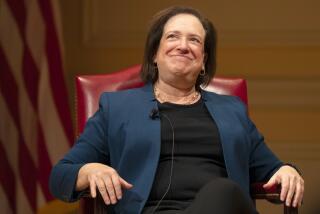Justices Clash Over Miranda Rule Decision : 2nd Confession Held Valid Despite Tainted Initial Admission
- Share via
WASHINGTON — A sharply divided Supreme Court, clashing over the controversial Miranda rule, said Monday that a second confession may be used at trial--even if a previous confession was made before a suspect had been notified of his legal rights.
In a 6-3 decision, the court said that a suspect’s second confession, made after a valid warning of his rights to silence and to legal counsel, is admissible so long as the earlier statement was not coerced by officers.
The decision was marked by an unusually acerbic exchange between the court majority and dissenters.
46-Page Dissent
Justice William J. Brennan Jr., in a 46-page dissent joined by Justice Thurgood Marshall, said that the ruling threatened “disastrous consequences.” Brennan accused the current court of engaging in a “studied campaign” to undermine rights established when the court under Chief Justice Earl Warren issued the Miranda rule 19 years ago.
“Today’s decision,” he added,” . . . delivers a potentially crippling blow to Miranda and the ability of the courts to safeguard the rights of persons accused of crime.”
In reply, Justice Sandra Day O’Connor, the author of the majority opinion, accused Brennan of taking an “apocalyptic” view of the ruling that “not only distorts the reasoning and holding of our decision, but, worse, invites trial courts and prosecutors to do the same.”
The now-famous Miranda rule emerged from the landmark 1966 Supreme Court decision in Miranda vs. Arizona, in which the justices ruled that suspects held in police custody must be told that anything they say can be used against them and that they have the right to silence and to have a lawyer before officers may question them.
Generally, statements made in the absence of such warnings may not be used in court, although the justices ruled last year that statements elicited from suspects when “public safety” is at stake may be admissible even if no Miranda warning was given first.
In Monday’s case (Oregon vs. Elstad, 83-773), officers in Polk County, Ore., investigating a $150,000 burglary in 1981, went to the home of 18-year-old Michael James Elstad, who had been implicated by a witness to the crime. An officer talked briefly with Elstad about the burglary, and the youth volunteered that he had heard about the crime. When the officer said that he thought Elstad was involved, Elstad replied: “Yes, I was there.”
Made Formal Statement
At the sheriff’s office, Elstad was told of his rights for the first time and then gave a formal statement admitting guilt. At his trial for burglary, the judge excluded Elstad’s initial statement--”I was there”--but admitted into evidence his subsequent formal confession. He was convicted and sentenced to five years in prison.
The Oregon Court of Appeals overturned the conviction, saying that the second statement should not have been admitted because it was “tainted” by the first.
The Supreme Court, in reversing the Oregon court, said that there was no need to bar a second statement, after a valid warning, so long as there had been no “deliberately coercive or improper tactics” in obtaining the first statement.
“A subsequent administration of Miranda warnings to a suspect who has given a voluntary but unwarned statement ordinarily should suffice to remove the conditions that precluded admission of the earlier statement,” O’Connor wrote.
Coercive Tactics Barred
The majority reaffirmed that the court would not condone coercive tactics that undermine a suspect’s desire to remain silent. Nonetheless, Brennan issued a far-ranging condemnation of the decision, accusing the court of ignoring the “realities” of police interrogations and failing to realize that a first confession obtained without Miranda warnings could enable authorities to get subsequent admissions “on a silver platter.”
Brennan warned that policemen now may purposely withhold a warning until the end of an interrogation session, getting a suspect to confess first and then notifying him of his rights just before he takes pen in hand to sign an incriminating statement.
In a separate dissent, Justice John Paul Stevens expressed fear that the decision would breed “confusion and uncertainty.” He added that it “denigrates the importance” of the Fifth Amendment’s privilege against self-incrimination--”one of the core constitutional rights that protects every American citizen from the kind of tyranny that has flourished in other societies.”
Bar Residency Law Voided
In other actions, the court:
--Ruled 8 to 1 that states may not automatically prohibit a non-resident lawyer from being admitted to practice law within their borders (New Hampshire vs. Piper, 83-1466). The court, in an opinion by Justice Lewis F. Powell Jr., threw out a residency rule imposed by New Hampshire on Kathryn A. Piper, who lives 400 yards across the border in Vermont and had sought admission to the New Hampshire bar. By recent count, about 23 states--not including California--maintain residency laws.
--Refused over dissents by Brennan and Marshall to review the case of mass murderer John Wayne Gacy, convicted and sentenced to death in Illinois for the slayings of 33 young men and boys (Gacy vs. Illinois, 84-511).
--Refused to hear a challenge to a Federal Communications Commission policy of granting members of racial minorities preference in the issuance of broadcasting licenses. White applicants who had unsuccessfully sought a license for an FM radio station in Hart, Mich., brought suit against the FCC, charging that a black applicant had been awarded the license unfairly. A federal appeals court in Washington upheld the FCC decision (West Michigan Broadcasting Co. vs. FCC, 84-700).
More to Read
Get the L.A. Times Politics newsletter
Deeply reported insights into legislation, politics and policy from Sacramento, Washington and beyond. In your inbox twice per week.
You may occasionally receive promotional content from the Los Angeles Times.









